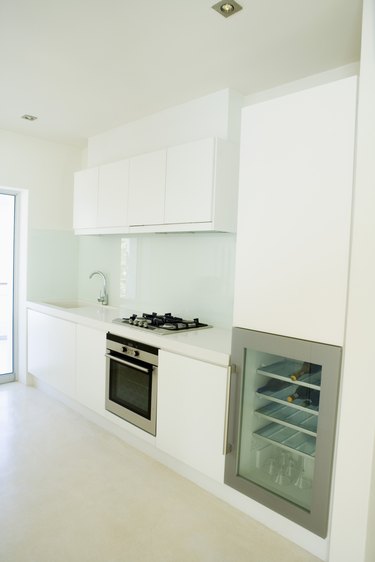
Paint is a quick and inexpensive way to add personality and style to a room. It also needs to meet the practical demands of everyday living, however, which means choosing the right paint for the space. On walls that are likely to be splattered, such as in the kitchen, applying a paint that will be easy to clean is essential.
Oil-Based or Latex
Video of the Day
The first decision you must make when selecting paint is whether to use an oil-based or latex paint. In general, latex paint is preferred, because it dries faster and cleans up with water. Latex paint is not as durable as oil-based, however, and walls painted with latex are not as easy to clean. Alternatively, oil-based paint takes longer to dry, fades more quickly than latex and requires the use of mineral spirits to clean brushes and rollers. Both types of paint can be used on the wall behind the stovetop.
Video of the Day
Choosing a Finish
Paint comes in a range of finishes, from a flat matte to a high-gloss. The glossier a paint is, the easier it will be to clean once it's on your walls. Walls painted with a high-gloss finish will be the easiest to wash, but this finish will make your wall look shiny and also make imperfections on the wall more noticeable. For a wall that is washable without being too shiny, choose an eggshell, satin, or semi-gloss paint. You may want to use a high-gloss on the wall directly behind the stove and use a less shiny finish for the rest of the room.
Surface Preparation
Prepare the wall surface to ensure the paint bonds to the wall. Scrape off old, flaking paint, fill in holes and wash the wall thoroughly. Washing the wall is especially important in a kitchen, where old grease stains could interfere with the new paint's ability to adhere.
Prime the walls to be painted using a white or tinted primer. As with finish-coat paint, you must decide whether to use a latex or oil-based primer.
Cleaning Painted Walls
According to the University of Michigan Extension, you can clean most painted walls with a solution of water and a mild detergent. For very dirty walls, first vacuum to remove dust and dirt. Then, working from the bottom up, wash walls with a mixture of 2 tbsp. ammonia or 2 tbsp. laundry detergent powder in 1 gallon of warm water. Wash one area, then rinse with plain water before moving on to another section of wall.
Conduct a test on a hidden area before using any cleaning solution on your entire wall. After ensuring that the solution has not damaged the paint finish, use it to wash the rest of the wall.